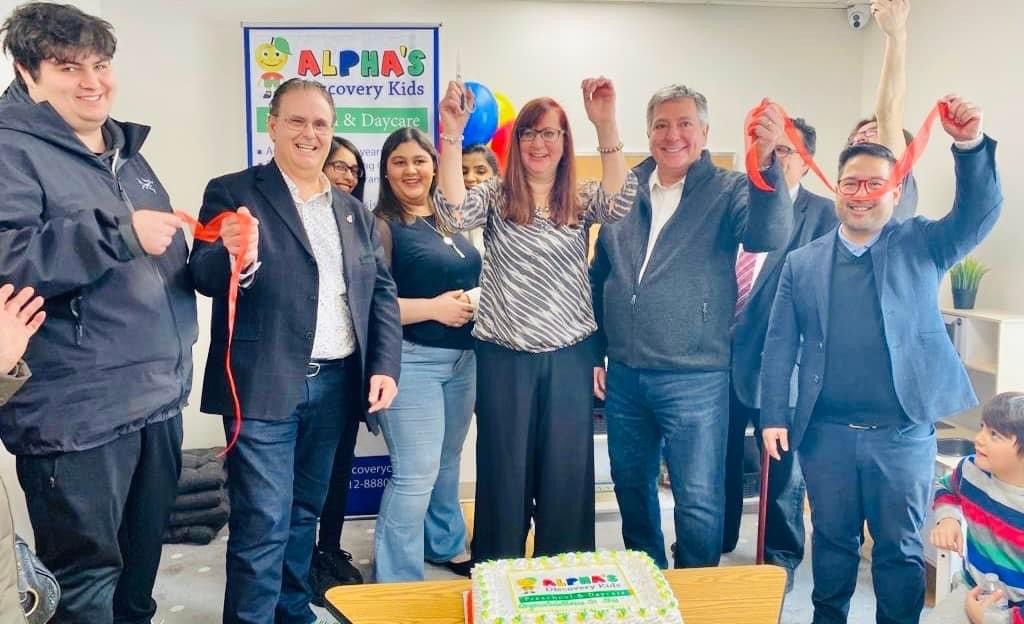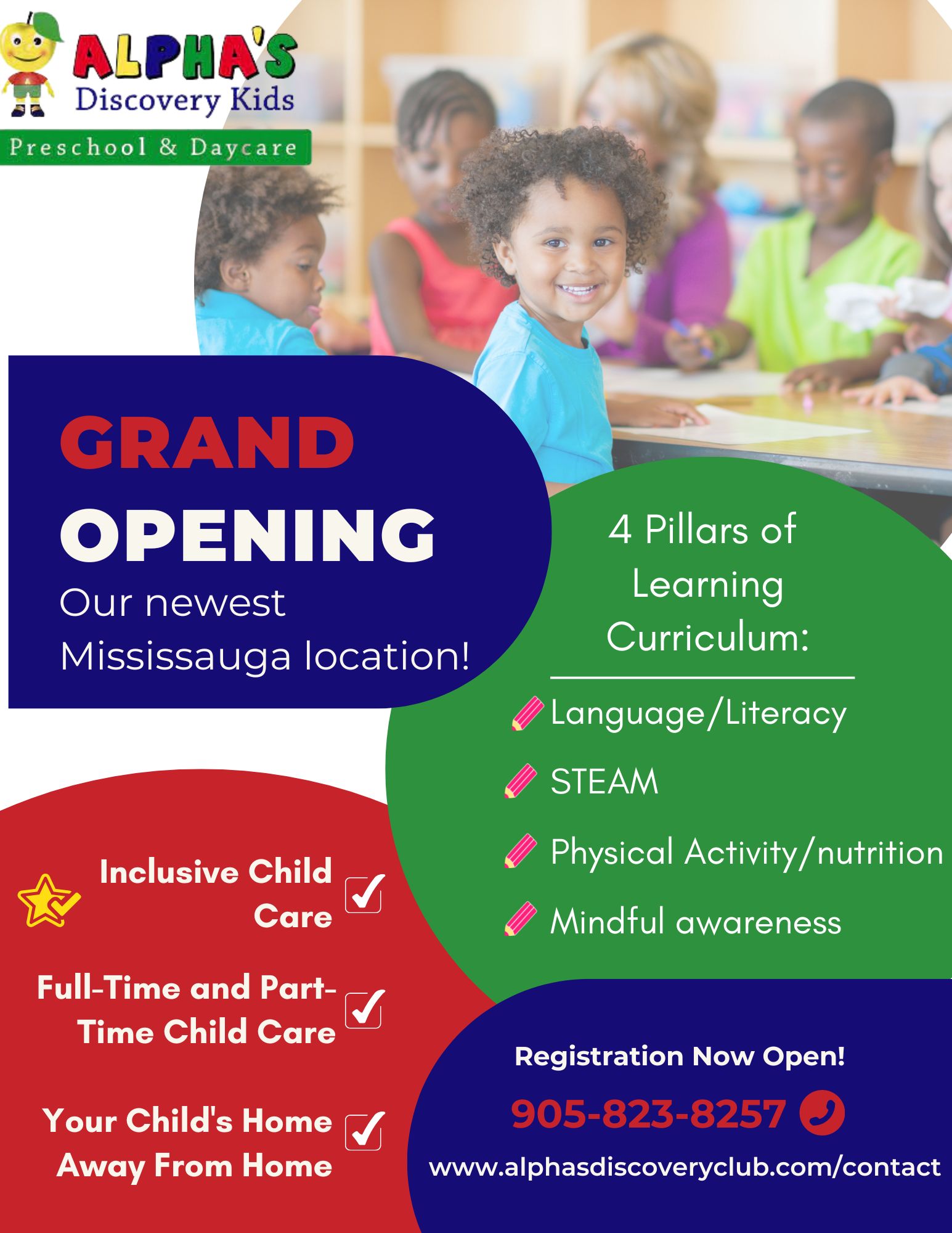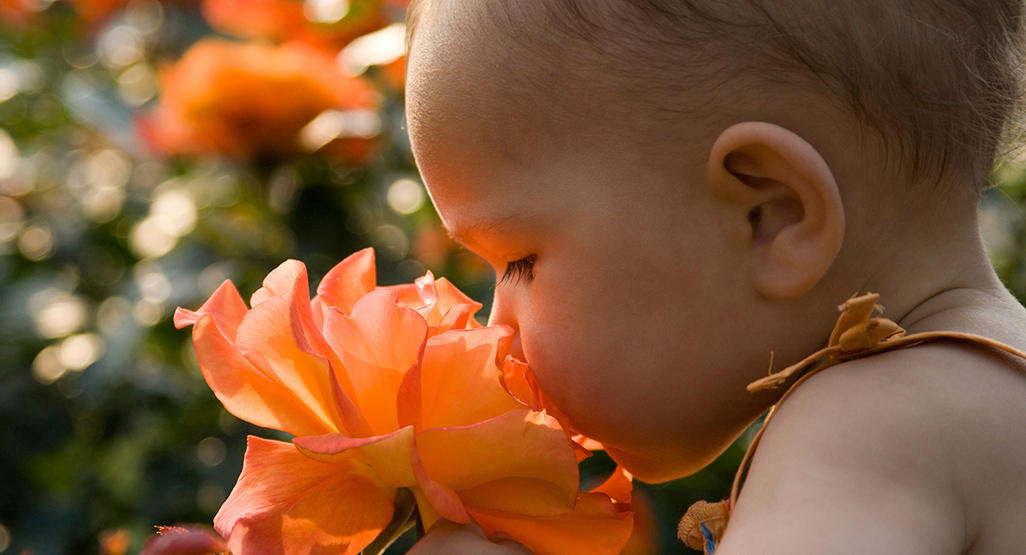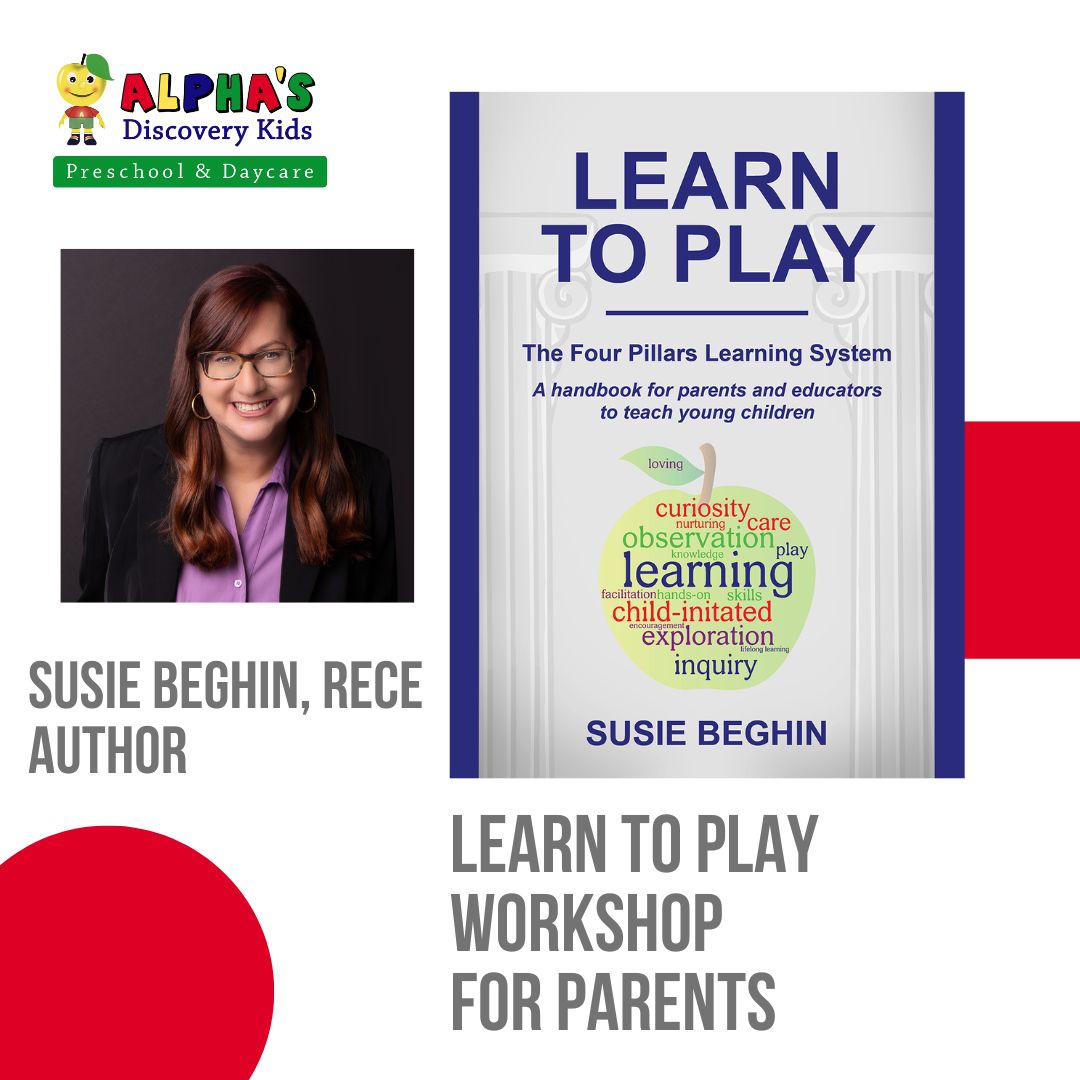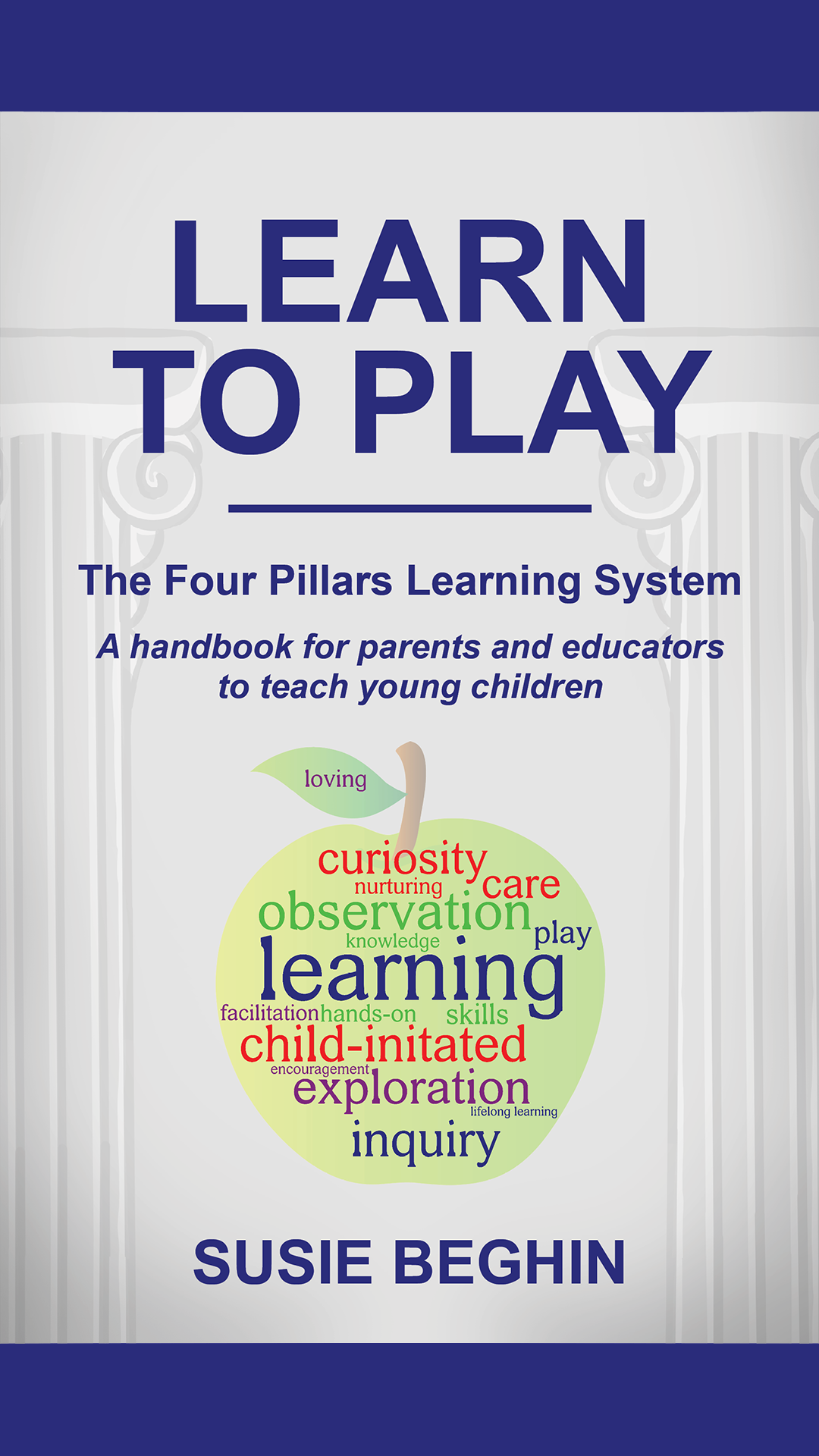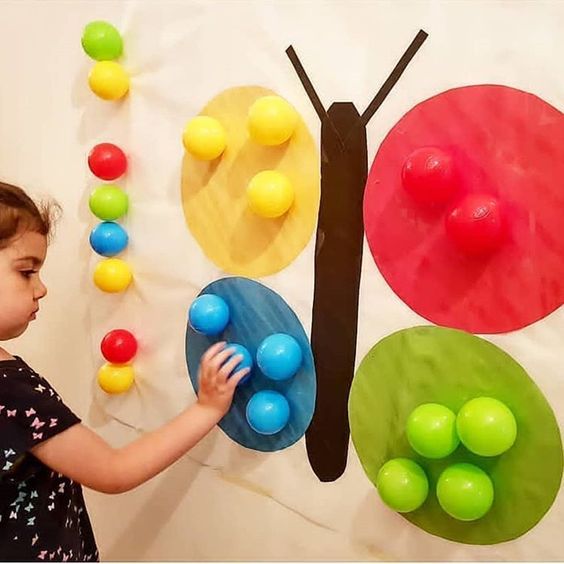Alpha’s New Mississauga Daycare Location Grand Opening event!
Alpha’s Discovery Kids New Mississauga Daycare Location Grand Opening event!
by Susie Beghin, RECE, Founder of Alpha’s Discovery Kids
It’s hard to believe that our new Mississauga Daycare location has been open for 1 month already. This has been a whirlwind of excitement, and we couldn’t be more thrilled to be able to welcome more families and children to their new ‘home away from home.’
We are beyond ecstatic about how well-received our new location has been, and we have just wrapped up our fantastic grand opening event, which took place on February 25th, 2023.
I feel a mixture of joy, happiness and sincere gratitude for everyone who supported me along the way and made this newest Alpha’s Discovery Kids location possible. Our event was a true celebration of support and community and I couldn’t be more proud of this brand new centre.
A recap of our grand opening event
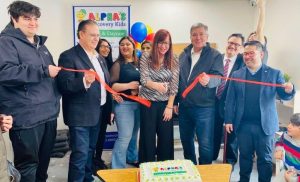
A day to remember, our grand opening event was a huge success. In addition to the many new and existing families and children of Alpha’s Discovery Kids, our families, friends, colleagues and community members, we were pleased to have welcomed distinguished guests, Charles Sousa, Member of Parliament of Canada – Mississauga-Lakeshore, Rudy Cuzzetto, Member of Provincial Parliament – Mississauga-Lakeshore and Councillor Alvin Tedjo, Ward 2 Mississauga, and we are incredibly thankful that they took the time to attend and support this event.
Our children are our future, and having the support of all those who attended means the world to us. It was an incredible sight as we were able to see the reactions of everyone who toured our new centre. I couldn’t be more proud to provide a safe space where our children can be cared for in a fun, loving, educational environment.
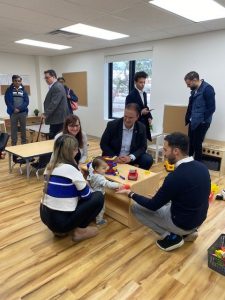
And earlier this month, we had the absolute pleasure of welcoming Ontario Education Minister Stephen Lecce to our daycare. We are incredibly grateful for the support of Mr. Lecce, and for his participation in celebrating our grand opening.
Our new Mississauga Location
Bright, airy classrooms. Fresh white walls. A blank canvas to create multitudes of amazing memories. Our newest location has been a true labour of love.
And this weekend, we were able to celebrate everything our new location has to offer. With 6 classrooms that can accommodate 93 children, flexibility with both part-time and full-time care available and an inclusive environment where every child is welcome, the feedback we have received has been outstanding.
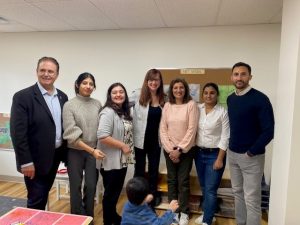
At the core of Alpha’s Discovery Kids is our unique 4 Pillars of Learning Curriculum. With the first 6 years of a child’s life being the most formative, it is imperative that we help children understand they can grow to be anything they desire.
From Language/Literacy, STEAM (Science, Technology, Engineering, Art, Math), physical activity/nutrition and mindful awareness, these 4 Pillars are integral to everything we do. And in our new location, these pillars are reflected in every room you visit.
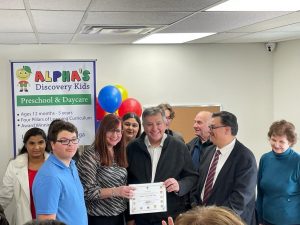
MPP Charles Souza stated “Early years education is so critical, and we know how important it is in terms of everyone becoming who we are today and leaders of the world thereafter. Using the 4 Pillars of Learning principles that Susie talked about, is essential.”
Alpha’s Discovery Kids offers a family first mentality, caring and experienced teachers and thoughtfully laid out spaces meant to foster children’s creativity while ensuring the well-being of each child is at the forefront.
Each of our Alpha’s Discovery Kids locations echoes our core values while aiming to provide warm, consistent care that helps spark children’s natural curiosity, exploration, play and inquiry. From nurturing staff, to community involvement, to flexible, safe learning spaces, we are pleased to provide our families with childcare they have come to trust.
Our commitment to offering safe, exceptional childcare is our top priority and having the ability to host our families and community members in our newest Mississauga location is truly the icing on the cake.
Thank you to each and every one of those who attended our grand opening celebration and for making it such a great success. We look forward to welcoming families to Alpha’s Discovery Kids!
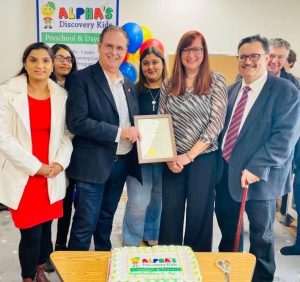
We can’t wait to welcome you to Alpha’s Discovery Kids!
Our New Mississauga Daycare Location is located at 2632 Liruma Road, Mississauga, ON L5K 1Z1. To book a tour or for more information, please contact us at https://www.alphasdiscoveryclub.com/contact/ or call us at 905-823-8257.
Alpha’s Discovery Kids – Your home away from home
Alpha’s Discovery Kids – Your home away from home
by Susie Beghin, RECE, Founder of Alpha’s Discovery Kids
“Family is not an important thing. It’s everything.” – Michael J. Fox
Every year, Family Day is celebrated across Ontario to bring families together – to strengthen their ties and celebrate what family means to each of us.
As a parent, nothing is more important to me than my family. And at Alpha’s Discovery Kids, we like to think of ourselves as part of your family, where our goal is to create a nurturing, safe space where every child feels that they are at their home away from home.
It truly takes a village to raise a child, and we certainly take this to heart. With a ‘family first’ mentality, we understand that as a parent, if you are not able to be with your children throughout the day, you want to ensure you’re leaving your child in the care of those who will treat them as you would.
I feel that no other word better encompasses what we do every day than love. And loving each and every child that comes into our doors is what we do best. Being part of the Alpha’s Discovery Kids family means having your own extended family, one who wants the best for each family member and shows this during every interaction.
As an Early Childhood Educator, I fully understand the needs and requirements of children and how daycare can make such a drastic change to their lives. And I feel blessed to be able to provide an environment where each teacher becomes an extension of your family. Where family and core values are incorporated into every child’s learning. Where comfort and safety are a top priority. And where the opportunity to teach children some of their most important life skills is a responsibility each of us takes to heart.

The Alpha’s Discovery Kids Difference
At Alpha’s Discovery Kids, we know that the first six years of a child’s life are the most formative. These are the years when young brains develop rapidly, and children are like sponges, soaking up information and modeling behaviours from those around them.
And it’s only when a child feels loved and secure that they will develop the confidence needed to explore and learn. That’s why each of our ECE teachers are hand-picked for their loving nature and wealth of experience working with children.
Providing the best learning environment possible is at the core of everything we do. And that’s why we have created an emergent, inquiry-based curriculum that sets children up for academic success. With each child’s unique strengths taken into account, we believe in child-initiated and teacher-supported learning experiences that foster their naturally inquisitive nature and cater to their individual needs. We do this by focusing on our Four Pillars of Learning:
- Language/Literacy
- STEAM (Science, Technology, Engineering, Art, Math)
- Physical Activity/Nutrition
- Mindful Awareness
With opportunities to create, build and explore abound, we have created a warm and caring environment where kids can be kids.
Every space in each of our Alpha’s Discovery Kids locations has been modelled with a child’s comfort and needs in mind. With classrooms designed to create a feeling of home, we always strive to make the hours they spend away from home filled with learning, familiarity and fun.
From toys that many kids might already have at home to our family board, where children can see photos of their families throughout the day, showing kids that they are important and loved is woven into every single thing our teachers do.
We can’t wait to welcome you to Alpha’s Discovery Kids!
With our Alpha’s Discovery Kids family growing at an incredible rate, we are so excited to welcome more families to become a part of our own.
We have just opened our amazing new Mississauga location and are excited for you to see it! With most spaces being booked on the spot, we encourage you to book a tour today or come to the Grand Opening event on Feb 25th from 10 am – 12 pm.

To book a tour or for more information, please contact us at https://www.alphasdiscoveryclub.com/contact/ or call us at 905-823-8257.
Alpha’s Discovery Kids Celebrates Their 2nd Mississauga Location Opening!
Alpha’s Discovery Kids Celebrates Their 2nd Mississauga Location Opening!
by Susie Beghin, RECE, Founder of Alpha’s Discovery Kids
As I walk into our bright, brand-new Mississauga daycare location, I’m overwhelmed with pride and happiness. From the new shiny floors to the perfectly white walls, I can’t wait to see our newest location transform from a blank canvas into many children’s home-away-from-home.
As an ECE (Early Childhood Educator), and a mom, there is nothing more fulfilling to me than being able to help the many families in our community by providing them with a safe place where their children will be nurtured and cared for in a fun and educational environment.
The History of Alpha’s Discovery Kids
Alpha’s Discovery Kids has certainly transformed since its birth in 2004. We started as Alpha’s Discovery Club, an indoor playground, and evolved into our first daycare location in Mississauga in 2012. Built from ground zero, we started with no students and quickly transitioned to full programs and a packed waiting list and, from there, opened our 2nd location in Oakville in 2019.
And here we are today. Opening our 2nd location in Mississauga – and we couldn’t be more thrilled!
A true labour of love, Alpha’s Discovery Kids is more than just a daycare. It’s many children’s second homes and second families. As a parent, I understand the trust and faith it takes to leave your child in someone else’s care. And that’s why at Alpha’s Discovery Kids, every child in our care is treated as an extended part of our own families. Our children are our most precious gifts, and we always aim to teach and nurture children in a loving, respectful manner. Our goal is to do our best to give them our best.
With over 10 years of experience, we pride ourselves on our family environment, where every single experienced teacher is chosen because they are caring, flexible and nurturing, with a capacity and desire for life-long learning. With an ever-evolving field, we are constantly learning – learning more about children and how to teach them, learning new strategies and techniques and learning how to deliver the best care to every child.
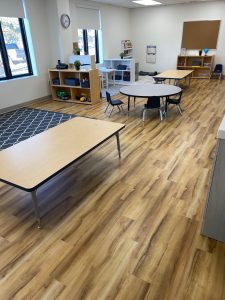
A peek inside our new Mississauga location
“My mission is to give each child the best start in life” – Susie Beghin
The first 6 years of a child’s life are the most pivotal. With a child’s brain growing at an exponential rate, as Early Childhood Educators, we are helping to form these little brains, so they grow and become anything they desire to be.
We consider ourselves blessed to be able to have an impact during these formative years, and it’s why our unique curriculum is the key part of all of our programs at every location. We have developed The Four Pillars of Learning, and these pillars are reflected in every room inside our Alpha’s locations. Our Four Pillars of Learning are Language/Literacy, STEAM (Science, Technology, Engineering, Art, Math), physical activity/nutrition and mindful awareness.
Our new Mississauga location embodies everything that Alpha’s Discovery Kids is about. Fresh, clean and inviting, with a capacity of 89 children, we are excited to welcome the newest members of our Alpha’s family. Each classroom has been thoughtfully laid out, from bathrooms set up within the classrooms (with mini toilets made for mini bodies!), to organized storage, to our Four Pillars of Learning areas.
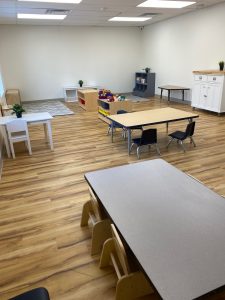
We have 6 classrooms at our new Mississauga location, divided by age group:
- 2 Toddler Rooms (ages 12m-2.5 yr) with a capacity for 14 children in each room
- Junior Preschool Room (age 2.5-3.5 yr) with a capacity for 16 children
- Senior Preschool Room (age 3.5-4.5 yr) with a capacity for 16 children
- Kindergarten Room (age 4-6yr) with a capacity for 13 children
- School Age Room (age 6+ yr) with a capacity for 19 children
With teachers who are always patient, caring and committed to making each child’s experience the best it can be, Alpha’s Discovery Kids is a loving and inclusive daycare whose top priority is the well-being of each child.
We are pleased to offer:
- Flexibility: We understand every family has different needs. We work with each family according to their schedule, offering both full-time and part-time We will always do our best to accommodate your schedule based on availability.
- Inclusive environment:
- Every child is welcome at Alpha’s Discovery Kids. We are a fully inclusive daycare experienced in welcoming special needs children. We also participate in PIRS (Peel Inclusive Resource Services), providing additional support services to children with special needs.
- We celebrate diversity and all cultures at Alpha’s Discovery Kids. We accommodate all dietary restrictions, offer a fully Halal menu, and are Halal Certified. Our menu is designed with a child’s nutrition in mind, and we offer nutritious, hot meals representing all food groups
- Technology: We understand that it can be difficult to leave your child at daycare, and that’s why we use our HiMama app. Giving families peace of mind, the app provides the ability to check in with teachers, see photos and videos of your children, see the schedule of the day’s activities and receive real time reports of your child’s day (including food consumption, sleep schedule, etc)
We’d love for you to come in and take a tour of our new location, and we are now accepting registrations. With many of our families booking on the spot, we encourage you to book your tour today.
The response to our new Mississauga location has been overwhelmingly positive, and we are so happy that our families love our new space.
We can’t wait to welcome you to Alpha’s Discovery Kids!
Our New Mississauga Location is located at 2632 Liruma Road, Mississauga, ON L5K 1Z1. To book a tour or for more information, please contact us at https://www.alphasdiscoveryclub.com/contact/ or call us at 905-823-8257.

5 Ways to Tap into Your Inner Child
5 Ways to Tap into Your Inner Child
by Susie Beghin, RECE, Founder of Alpha’s Discovery Kids
As an educator, parent, and daycare owner, I feel blessed to be around children every day. Being with children has allowed me to learn how to tap into my own inner child. I have seen firsthand how important it is to my relationship with them. Children tend to engage with me and seek me out when I’m connected to my inner child.
What is the Inner Child?
The Inner Child lives inside you. It can best be described as “child-like”, innocent and free from worry. It can’t be taken away, but it can hide. It’s like a light shining within you that can’t burn out, but it can be temporarily dimmed.
Why tap into your Inner Child?
There are a couple of important reasons to tap into your inner child. One of the main reasons you will want to do this is to feel more joy and energy in your life. Have you ever noticed that children seem to be full of joy most of the time? They tend to smile and laugh more than adults. They are full of energy! The second reason is, as a parent, it will strengthen your relationship with your children. In the book Learn To Play, I state the importance of tapping into your inner child when you are playing with them. It will allow you to influence and educate them in the best way possible. And finally, it’s good for your mental health. When you tap into your inner child, it feels good!
5 Ways to Tap into Your Inner Child
- Spend Time with Children in Play – I found this way to be the easiest. Children naturally will bring out your inner child when you are playing with them. Resist the urge to direct the play. Just follow along with what they are doing. The more you follow, the more your inner child will come out. Let yourself be free in the play. Don’t worry about anything – like making a mess. Don’t be afraid to get silly and don’t worry about what anyone else thinks. Be playful and have fun.
- Be Curious – We can learn how to be curious by observing children. They naturally have a sense of wonder and curiosity about everything. They are learning about their world and there are many new things to learn. A baby is just figuring out how to open and close a kitchen cupboard. Imagine their excitement when they finally get it open! They want to do it repeatedly! Children are like scientists that are always testing a hypothesis. They are curious about how things work. We need to see the world in the same way. We need to be curious and look at the world with the eyes of a child.
- Be Mindful – Being mindful means focusing on the present moment without any judgement. Children are naturally mindful and have a heightened sense of awareness. They tend not to worry about the past or future and are mostly focused on what is happening in the present moment. We can learn a lot from children in this regard. Many of our worries and problems arise when we are too focused on the past or the future. We forget to enjoy the present moment, which is full of opportunities and joy. Want to learn how to be mindful? Click here and watch one of our videos about how to cultivate mindfulness.
- Look up – We live in a world with a lot of distractions and mobile phones have had a huge impact on us. I am guilty of spending too much time looking at my phone and scrolling through social media instead of enjoying the scenery on a drive. I have sat at the dinner table answering a message on my phone instead of engaging in conversation with the people sitting beside me. These same phones that are supposed to connect us to the world, often tend to disconnect us – emotionally. When we look up from our phones, we notice the world around us in a new way. We can’t engage with that world if we are looking down. Our inner child needs us to look up.
- Do something new – One of the best ways to challenge yourself to tap into your inner child is to try something new. Learn a new language, visit a new destination, or try out a new craft. Whatever you do, make sure you haven’t done it before. This will challenge your brain to make new connections the same way a child does when they learn something new.
Once you learn to tap into your inner child, you will be well equipped to engage with you kids and build the relationship. The spark is within you, you just need to let it shine!
Learn to Play Workshops: For Parents
Learn to Play Workshops: For Parents
Susie Beghin wants to give children the best start in life. It’s why she founded Alpha’s Discovery Kids in 2012, a daycare and preschool dedicated to providing quality education and a positive learning environment.
Now, Susie shares the foundation of Alpha’s Discovery Kids’ beloved and celebrated inquiry-based curriculum in her new book, Learn to Play: The Four Pillars Learning System.
Learn to Play: The Four Pillars Learning System, is a must-read for all parent-to-be or parents with young children! In the book, Susie shares her teaching method with parents and educators as a tool for learning both at home and in the childcare setting. For each pillar of learning, there are strategies on how to build skills as well as sample free-play and intentional play activities – by age group, from infants to preschoolers.
Susie is now offering workshops to teach the fundamental concepts in the book for parents who want to learn how to teach their kids through play. She is inviting parents to participate in the free workshop to explore the book in a hands-on learning environment. Note: parents must purchase the book to enroll in the free workshop.
The workshops will be held monthly at the following location:
Alpha’s Discovery Kids – Mississauga
6435 Erin Mills Parkway E-02 Mississauga, ON L5N 4H4
Tickets available on EventBrite. Click here to book tickets.
Learn To Play: The Four Pillars Learning System
Learn To Play: The Four Pillars Learning System
Book Release
My mission is to give children the best start in life. – Susie Beghin
Did you know that children between the ages of 0 and 6 years old learn more in those early years than they ever will again in their lives?
That’s why it’s so important to teach them well during those early years! Those early years will have an impact on them like no other time of their lives.
Our founder, Susie Beghin, just released a new book called “Learn to Play: The Four Pillars Learning System“. In the book, she talks about the important role that parents play in the education of their young children during this critical period of their lives.
“I wrote this book during the pandemic because I saw parents struggling with educating their kids. I want parents to know their crucial role in the education of their children – and I’m here to help them. I want to give parents and educators the tools they need to educate those kiddos using a proven system! In the book, I share the Four Pillars learning system we use in the daycare environment and how parents can use those same strategies at home. Essentially, I want to help parents become the educators and play partners that their children need them to be!”
Susie will be signing her books at her official book launch in Mississauga on September 25th from 2-4 pm. There are limited tickets (only 100 tickets available) and the event is free! Refreshments will be provided. Books are available for purchase at the event at a discount. Click here to book your tickets to the event on Eventbrite.
The book is now available in Canada on Amazon if you want to purchase an advance copy.
U.S. or International can purchase here.
10 Years – A Reflection
10 Years – A Reflection
By Susie Beghin
As we approach the 10-year anniversary of Alpha’s Discovery Kids Preschool and Daycare, this is a great opportunity to reflect on the past 10 years and recognize those who have made it all possible.
When I first started the business in 2004, which was originally called Alpha’s Discovery Club, it was an indoor playground that provided educational entertainment and extra-curricular programs for children up to 10 years old. The business evolved over time, and it became clear to me that my dream was to open an education-focused child care facility for young children.
I realized that dream in 2012 – 10 years ago – with the first location in Mississauga called Alpha’s Preschool Academy and Child Care Centre. Over the years, the name changed slightly to what is now known as Alpha’s Discovery Kids Preschool and Daycare.
When we first opened our doors in September 2012, we had 8 children enrolled. Over the years, we have grown to our full capacity of 69 kids and expanded to open other locations in Oakville and Mississauga.
It wasn’t easy to leave my previous “corporate” job and start a new business. But I felt almost compelled to do it and haven’t looked back! It was the best decision of my life. I would say that my inspiration for starting Alpha’s was my son Gabriel, born in 2002. It was by being his mom that I learned that my true passion in life was to work with kids. In 2007, my son John-Michael was born, and he inspired me to pursue the dream of owning my own daycare – which came to reality a few years later in 2012.
We have had some very special educators that have been with us throughout these 10 years that have made a huge impact on our organization. Amanda, Roda, Meg are educators who were with me from the very beginning and are still educating children at Alpha’s. I am so thankful to all our educators – past and present! They have helped us create a unique curriculum called The Four Pillars of Learning. Through their hard work, they have contributed to make Alpha’s a place that I am truly proud of!
When I look back over these years, I can’t help but smile. I think about how lucky I am to be doing something that I love every day. I am truly honoured to be involved in the formation of these precious “Alpha’s kids” in our care. We are so grateful to the parents for their trust and support over the years. These little ones have made me smile and laugh – it is truly a joy to watch them learn!
Finally, I want to give special recognition to my husband, Adriano, who has supported me throughout these 10 years, both financially and emotionally. He has made it possible for me to follow my dream! Without him, Alpha’s would never exist!
Join me on August 27th as we celebrate this special 10th anniversary with a huge carnival theme party!
Here’s the details:
Saturday August 27, 2022
11:00 – 2:00 pm
Free Admission
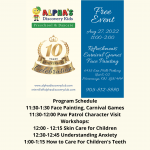
Meal planning for Busy Parents: 5 tips for budget-friendly meals
Meal planning for Busy Parents: 5 tips for budget-friendly meals
As busy parents, it may be difficult to get a nutritious meal on the dinner table each night. And with food costs rising, it may be difficult to do so with a limited budget. I am sure that you have often thought, “What am I going to make for dinner tonight?”. Rest assured, you are not alone. It is possible to feed your family nutritious meals almost every day. Here’s five tips to help you offer nutritious meals for your family on a budget!
-
Plan Ahead
I’m sure you have heard that planning is the key to healthy eating. When we fail to plan, we often choose less nutritious food choices. This doesn’t mean you need to map out each meal and snack for the entire week and stick to it. This approach is probably doomed to fail for most of us. It’s difficult to stick to a rigid meal plan. Instead, try to plan out the week by sketching out a rough meal plan centered around your proteins and think about how you will prepare the meals each week. You can start by choosing to plan the dinners only. Remember to make allowances for your schedule and obligations. For example, if you know that you will be working late one night, you will choose any easy dinner that might include leftovers from a previous meal or something that is simple to make.
-
Shop Wisely
Shopping for food also involves some planning. It’s best to plan out what you will buy before going to the grocery store. To extend your food dollar further, try planning your meals around the weekly sale and promotional items. Use coupons and price matching to purchase items that you need. Purchase off the reduced racks if you can use the items quickly. It will save you money if you check your fridge/freezer/pantry at home prior to shopping. Many times, we buy items that we already have at home because we failed to check what we have. Most importantly, stick to the shopping list and avoid shopping when hungry or emotional. Stay clear of those eye-catching food displays too! This will help you to avoid impulse buying which often adds up at the cash register. Another budget friendly tip is to know how grocery stores place their products. The most expensive items are usually at eye level on the shelf. Try to look above and below eye level for better deals.
-
Choose One Plant-based Protein Meal each week
You will save money by choosing one plant-based protein meal each week such as lentils, beans, or other legumes. These foods are also jam packed with fiber which we all need! Here’s a few great websites with lots of recipe ideas:
-
Make a Balanced Meal
According to the Canada Food Guide, your food plate should have a balance of protein, fruit, veggies, and grains. Fruits and veggies should make up half your plate. The other half is split equally between protein and whole grains. Choose foods that are in season to get the best value for your money and the best nutrition and taste. You can find out when foods are in season in Ontario by visiting https://www.ontario.ca/foodland/page/availability-guide. When you can’t buy items in season, you can choose frozen food options that were picked at the peak of the season.
-
Cook Smart
Having good cooking appliances, utensils and tools will make cooking easier. Invest in good quality appliances that can reduce cooking time or can be used hands-off, such as a slow cooker, instant pot, or air fryer. This will free up your time to do other things. Invest in good utensils and tools that make chopping and slicing easy too! When the cooking process is easy, you will be more motivated to make healthy meals.
You can involve your whole family (even the kids) in the entire process – from planning to shopping to cooking! Teaching about nutrition is one of our Four Pillars of Learning at Alpha’s Discovery Kids. You can find out more about our program and curriculum here.
Open House – Daycare and Summer Camp 2022
Daycare and Summer Camp Open House 2022
We are so excited to showcase our beautifully expanded and renovated facility in Oakville at our Open House this weekend. We want to give you a little sneak peek of the activities that will be offered for children during this event.

As families wander our hallways, classrooms, and outdoor playground area, they will see featured activities on display as well as engage in some hands-on activities with their children. This will give prospective families an opportunity to experience our Four Pillars of Learning curriculum first hand.
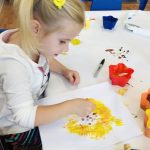
We will be offering some yummy snacks, treats and refreshments to enjoy during this event. We welcome children of all age groups to explore each room and participate in what is being offered along with their parents.
Our program grows with your child and because we know that your families are growing too, we have offerings that begin as early as infants all the way up to 12 years of age.

The founder of Alpha’s Discovery Kids and owner of all three Alpha’s locations, Ms. Susie will be here to meet and greet all guests. Our centre Supervisor Ms. Shannon will also be onsite ready to greet you with a smile, answer questions and offer a personal tour. Our talented team of core educators will be waiting for you in our classrooms ready to represent and showcase our proprietary holistic curriculum.

This event offers a unique opportunity for our existing parents to engage with each other and share their experiences with new families too. Even though we are a well-known award-winning location with a 5-star rating and amazing reviews, nothing beats a real parent to parent chat. We know that education, cleanliness, safety, food and nutrition, love and comfort are the top priorities of all parents. We can’t wait to open our doors and share what we have to offer. With a variety of programs and flexible options, there is sure to be something for everyone.

We offer Full-time, Part -time, Toddler, Nursery school, Jr. & Sr Preschool, Kindergarten, Before and After School – Age programs and Summer Camps.


Spring Cleaning for the Mind
Spring Cleaning for the Mind
Spring is all about fresh starts and new beginnings, symbolized by growth and new life. It’s a time when we are encouraged to clean our homes and organize our lives. It’s also a great time to give a little attention to renewing your mental health.
At Alpha’s Discovery Kids, we place equal focus on teaching children about mindful awareness and physical health as we do with teaching them academic skills. We do this because we know how important mental health is to the learning process. Engaging in self-care is fundamental to having a clear and refreshed mind. We often forget to take care of ourselves when busy schedules and caring for others is prioritized. We must actively listen to our mind and body and understand that taking time for oneself is not a luxury or an act of selfishness, but rather a critical element for self-growth and fulfillment. Doing this for ourselves is good for those around you too: your family, your co-workers, and it sets a good example for your children. You may wonder how we calm the busyness and begin the self -care process.
Here are 5 steps that can help you clear and refresh your mind, spirit and body.
5 steps to spring cleaning of the mind, spirit and body
1.Reflect
A clear mind begins with self-love and self-reflection. Self-love starts with taking the time to do the work that is needed to be healthier, happier, and more at peace with yourself. Once you have gifted yourself the time, then reflection can begin. How can we connect with what our mind and body are telling us if we don’t pause and listen first? Renewal of the mind, body and spirit is a journey, and is successful when practiced gradually. The good news is that you have already begun by taking the time to read this blog.
Here’s a little activity you can do to start the reflection process:
- Imagine yourself sitting beside the water and the waves are crashing. Try to find your reflection in the water.
- Now, imagine yourself sitting beside the water and there are no waves, and the water is still. Try to find your reflection in the water.
The waves represent your active and stressed mind. You can not see your reflection when the waves are crashing. You must calm the waves and your mind to reflect, refresh and renew. Each of these steps require a mind free of clutter and distractions. Find a quiet place at home or in nature and just take some time for yourself to reflect, without thinking about anything on your to-do list and make sure you don’t have a phone with you or anything else that may distract you.
2.Re-write short-term and long-term goals
It does not matter how big or small. Having a set of goals can give you a sense of purpose in life and guide you toward your desired path.
Short term goals that can bring you joy, and happiness can be as simple as:
- Reconnecting with an old friend by phone or in person.
- Taking more time to do enjoy a nice cup of coffee or tea alone
- Getting a fresh new haircut
- Forgiving someone who has done you wrong
Long term goals that can bring you joy, and happiness can be as simple as:
- Planning or completing a project at home
- Starting a new hobby
- Booking a trip
- Read a book
- Improving a relationship with someone you care about
3.Refresh Physical health
Engaging in physical activity has been scientifically proven to play an important role in sustaining mental health and well-being. This can be as simple as adding one healthy habit to your routine. or removing one unhealthy habit.
Here’s some ideas:
- Drink more water
- Park father away so you get a few more steps
- Put it away – Tidy up as you go
- Make your bed
- Opting for fresh over processed food
- Cutting back on sugar or salt
- Cut back on caffeine or Alcohol
- Take the dog out for a walk or run
- Sign up for a sport you enjoy
4.Renew your spiritual health
Practicing your faith can do wonders for cleansing of the mind. According to wellness coach and author of “The Adrenal Fatigue Solution”, there is a strong connection between faith and mental health. She states “There is one age-old method that can reduce stress levels. It’s free, doesn’t require a prescription, and has zero side effects or drug interactions. You will know it as faith, and millions of people around the world rely on it to see them through hard times. The results are not just anecdotal, there is evidence that it works. Faith and spirituality are abstract concepts, but they can lead to concrete results in mental health improvement and stress reduction.”
Whatever your faith is, spend more time with it. Really connect with it to engage your mind and spirit.
5. Rethink your stress management skills
Learning coping skills that allow you to accept any given situation is an important skill in reducing stress. Knowing which situations make you uncomfortable can minimize distress and encourage better coping behaviors. Making a conscious effort to notice and understand your inner and outer world at this very moment can improve your mental health. Living in the present moment is difficult when you are distracted with tasks and responsibilities. We forget to appreciate life’s precious moments.
Taking time to develop the skills needed to better manage your stress and anxiety can be as simple as:
- Take a brief pause in your day to indulge in a sensory experience (Smell something pleasant or touch something soft)
- Try your best not to dwell on what you can’t control or what is in the past
- Pay attention to what triggers your stress responses and avoid those things if possible
- Take a moment to notice the sun and wind on your face
- Remove physical clutter to clear mental clutter and stress
With these 5 steps to spring cleaning the mind, body and spirit, let’s take a moment to spring into action and be good to ourselves.

